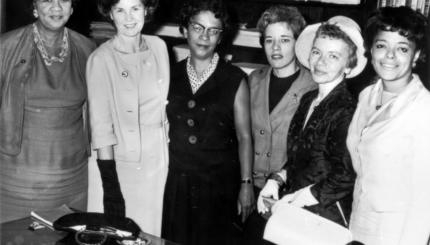As we prepare for the new year ahead, we’ll be sharing several Southern & Jewish posts reflecting on “how we spent our summer.” Today’s post come from two guests who visited us down South, Jay Saper and Margot Seigle.
This May, the two of us—white Jews who grew up in the Midwest—traveled down to Mississippi. Inspired by emerging efforts to develop the South as a hub for cooperative enterprise, we sought to learn more at the Jackson Rising New Economies Conference. Like the Jews involved in the Civil Rights movement in the generations before us, we came South, too.

Jay and Margot meeting with coordinators from the Cooperative Community of New West Jackson.
As we waited for the shuttle to pick us up from the Medgar Evers Airport to take us to Jackson State University, we strolled into an exhibit about the person after whom the airport was named. In 1954, Medgar Evers was appointed the first NAACP field secretary for the state of Mississippi. He traveled the state courageously advocating for Black rights.
Evers’ bravery came with a toll. After driving home on the evening of June 12, 1963, he took shirts reading “Jim Crow Must Go” out of the car to bring inside his home. He started up his driveway, but a bullet took his life before he could make it to the door.
The following year, building on Evers’ dedicated decade of organizing, a coalition of civil rights organizations launched Mississippi Freedom Summer. It was a summer of change – and of more loss. As we read the names of Chaney, Schwerner, and Goodman on the wall of the exhibit in the Jackson airport, we wondered at their legacy, and our own role in coming South.
At the Jackson Rising New Economies Conference we learned about an exciting way people in the South are working to challenge racism today: by building a democratic economy that meets their presently unmet needs. This approach to community resilience comes out of a long tradition documented by Jessica Gordon Nembhard in Collective Courage: A History of African American Cooperative Economic Thought and Practice.
We got to meet with John Zippert, a fellow Jew who has long acted in solidarity with Blacks in the South to advance racial and economic justice through the cooperative model. The son of refugees from Nazi Germany, Zippert was active in social struggles from a young age in New York City. In the summer of 1965, Zippert went South as a volunteer with the Congress of Racial Equality. He helped farmers looking for a better price on their sweet potatoes to set up a cooperative. Through this work he met Carol Prejean. The two would go on to be the first married interracial couple in Louisiana.
Since 1970, Zippert has been working for the Federation of Southern Cooperatives, an organization that grew directly out of the Civil Rights Movement. The Federation works to maintain Black owned land and expand the use of cooperatives for economic development. It has been integral to challenging discrimination against Black farmers by the USDA. In 2012, Tuskegee University inducted Zippert into the George Washington Carver Hall of Fame for his tireless dedication to those who are disadvantaged.
The organizers from Cooperation Jackson and the Southern Grassroots Economies Project communicated with us that the movement for economic democracy is building in exciting and powerful ways. There is still a lot of work to be done, and when we come together, that work can get done. That’s why we came South, and will continue to partner with the amazing individuals and groups fighting for social change today.
Like this post? Join the conversation through MyJewishLearning’s weekly blogs newsletter.


